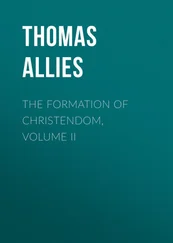Thomas Allies - Peter's Rock in Mohammed's Flood, from St. Gregory the Great to St. Leo III
Здесь есть возможность читать онлайн «Thomas Allies - Peter's Rock in Mohammed's Flood, from St. Gregory the Great to St. Leo III» — ознакомительный отрывок электронной книги совершенно бесплатно, а после прочтения отрывка купить полную версию. В некоторых случаях можно слушать аудио, скачать через торрент в формате fb2 и присутствует краткое содержание. Издательство: Иностранный паблик, Жанр: foreign_antique, foreign_prose, Историческая проза, на английском языке. Описание произведения, (предисловие) а так же отзывы посетителей доступны на портале библиотеки ЛибКат.
- Название:Peter's Rock in Mohammed's Flood, from St. Gregory the Great to St. Leo III
- Автор:
- Издательство:Иностранный паблик
- Жанр:
- Год:неизвестен
- ISBN:нет данных
- Рейтинг книги:4 / 5. Голосов: 1
-
Избранное:Добавить в избранное
- Отзывы:
-
Ваша оценка:
- 80
- 1
- 2
- 3
- 4
- 5
Peter's Rock in Mohammed's Flood, from St. Gregory the Great to St. Leo III: краткое содержание, описание и аннотация
Предлагаем к чтению аннотацию, описание, краткое содержание или предисловие (зависит от того, что написал сам автор книги «Peter's Rock in Mohammed's Flood, from St. Gregory the Great to St. Leo III»). Если вы не нашли необходимую информацию о книге — напишите в комментариях, мы постараемся отыскать её.
Peter's Rock in Mohammed's Flood, from St. Gregory the Great to St. Leo III — читать онлайн ознакомительный отрывок
Ниже представлен текст книги, разбитый по страницам. Система сохранения места последней прочитанной страницы, позволяет с удобством читать онлайн бесплатно книгу «Peter's Rock in Mohammed's Flood, from St. Gregory the Great to St. Leo III», без необходимости каждый раз заново искать на чём Вы остановились. Поставьте закладку, и сможете в любой момент перейти на страницу, на которой закончили чтение.
Интервал:
Закладка:
Whilst St. Theodore was at Constantinople the emperor Phocas suffered from gout in hands and feet. He sent for the saint, who laid his hands upon him and prayed for him. The emperor felt relief, and commended himself and his realm to Theodore's prayers. The saint replied that if he wished such a prayer to be heard he must cease from oppression and shedding of blood. Phocas had great need of such warning, but profited little by it. Narses was the ablest and bravest general whom he had to send against the Persians, but he broke his word, and had him burnt alive. This frightful execution moved the patrician Germanus to try after the place of emperor which Phocas had once offered to him. He planned a conspiracy with Constantina, widow of the emperor Mauritius. She had taken asylum with her daughters in Sancta Sophia. This was in 606. At the sight of her the people flocked together and took up arms. Phocas sent orders to bring out Constantina with her daughters. The patriarch Cyriakus refused: only when he had compelled Phocas to swear that no harm should be done to them, he gave them up. Phocas kept his word, and only confined them in a monastery. Germanus was forced to become a priest. In the next year, 607, Germanus and Constantina with other persons of high rank made a new conspiracy. It was discovered. Germanus with his daughter, the widow of prince Theodosius, eldest son of the preceding emperor Mauritius, was beheaded. The same lot befel Constantina and her daughters at Chalcedon, on the spot where, five years before, the emperor Mauritius had witnessed the execution of five sons, one after another, uttering at each stroke only the words: “Just art Thou, O Lord, and just is Thy judgment”: and then offering his own head to the sword. Phocas put to death the other conspirators with fearful tortures. Such executions were followed by fresh conspiracies, and these by similar punishments. At last, Crispus, the very stepson of Phocas, rose against him, and invited Heraclius, governor of Africa, to depose the emperor. Heraclius despatched a fleet under the command of his son, bearing the same name. Only as it drew near Constantinople did Phocas hear of it. He prepared for defence, but Crispus secretly traversed all his efforts, pretending to be on his side. After a bloody engagement the fleet appeared before the walls of the capital on Sunday the 4th October, 610. The next morning a senator, whose wife Phocas had dishonoured, appeared with a troop of soldiers at the palace. Phocas was seized, stripped of the purple, his hands bound behind his back, and carried through the city and the fleet before the young Heraclius, who was still on board his vessel. “Wretch,” said Heraclius, “hast thou governed the empire so?” “And wilt thou,” answered Phocas, “govern it better?” Heraclius trampled on him, cut off his hands and feet, and then his head, in sight of the vast throng which lined the shore. His head and limbs were carried on spears through the city, the trunk dragged through the streets, and all at last burnt.
Heraclius, accompanied by Crispus, disembarked. He invited Crispus to put on the imperial robe, since he was not come to invest himself with it, but only to avenge Mauritius and his children. Crispus refused, and then Heraclius had nothing to oppose to the request of the patriarch Sergius, who had just succeeded Thomas, that he should be crowned by him. Crispus was given the government of Cappadocia: but becoming a few years later unfaithful to Heraclius, as he had been to his stepfather Phocas, was compelled to receive the torture, and pass the rest of his days in banishment.
It may here be said that the dynasty thus begun occupied the throne for five generations. Justinian II., great-great-grandson of Heraclius, was more cruel if possible, than Phocas: he was deposed by an adventurer in 695, and his nose cut off to incapacitate him for any future recovery of the throne. His successor lasted three years: and another for seven; after which Justinian, who wore a golden nose for the one which he had lost, recovered the throne; practised during five years atrocious cruelties, was deposed by a third adventurer, Philippicus Bardanes in 711: put to death, and his head carried to Rome to assure all men that they were delivered from a tyrant, and a special oppressor of the Church.
Such in personal conduct was the manner of men who sat on the eastern throne of the great Constantine during the seventh century: whom four-and-twenty Popes found themselves bound to acknowledge as “Christian kings and Roman princes”. What they were in this capacity, which was the first and greatest of all their duties, as recognised by the imperial laws, will be seen as the narrative proceeds. Under these men the Popes, utterly deprived of temporal power, in the midst of a province an outlying domain of a distant despot, had to maintain the unity of the Christian faith, and the independence of the Holy See as its guardian. In the midst of these things the chalifs of Mohammed broke upon the eastern empire, and severed from it its fairest provinces. It is requisite to follow closely the series of events, and the connection of times.
Upon his accession to the throne in 603 Phocas had sent an embassy to the Persian emperor Chosroes, expressing his desire to maintain peace with him. But Chosroes under pretext of avenging his benefactor, the late emperor Mauritius, began a war which lasted more than four and twenty years, inflicted fearful sufferings on both empires, and had the most important consequences by leaving them in a state of great weakness to meet the assault of a new enemy, the Mohammedan chalifate.
During the first eighteen years of this war, that is, from 604 to 622, the Greek empire suffered a series of defeats and disasters. Through the whole East, from the ruins of Babylon to the Bosphorus, cities were burnt and destroyed, the country ravaged and left without cultivation, the inhabitants slain or carried away into slavery. The Persians tore from the empire province after province – Armenia, Mesopotamia, Cappadocia. In 610 they came up to the walls of Chalcedon. The accession of Heraclius produced no pause in their destructive course. In 611 they took Edessa, Apamea, and Antioch. In 615 they plundered Palestine, and took Jerusalem. The Church of Gethsemane, on the Mount of Olives, and Constantine's Basilica of the Holy Sepulchre were destroyed or burnt. Among the inhabitants carried away was the patriarch Zacharias. The Persians seized in plunder all that was valuable, and the priceless relic of the Holy Cross was taken away by the fire-worshipper Chosroes. The Sponge and the Lance were saved by the patrician Nicetas, who purchased them at a high price from a Persian soldier, and then brought them to Constantinople, where they were exposed for veneration of the faithful.
It is to be noted that in 610 the Jews at Antioch had an insurrection, and massacred a great number of the most considerable inhabitants. They seized the patriarch Anastasius II., whom we have seen St. Gregory treat with such regard; they frightfully maimed him, dragged him by the feet through his city, and finished by casting him upon a funeral pile. When Jerusalem was captured in 615, the Jews of Palestine bought of the Persians as many Christians as they could get, for the pleasure of strangling them. It is recorded that they murdered seventy thousand in this manner.
Eight days before the taking of Jerusalem the fortress monastery of Mar Sabas, 2000 feet above the Dead Sea, then, as now, of the greatest renown, was assaulted by the Arabs. All but fourty-four of the oldest monks had fled, but these remained, and, after its capture, suffered first grievous tortures, and at last martyrdom. When the monks who had fled returned, they found the bodies of their brethren unburied; the abbot Modestus gave them holy burial. He afterwards superintended the diocese of Jerusalem during the absence of the captive patriarch. What Monte Cassino is to Italy, and Mount Athos to Greece, Mar Sabas was then and is now to Palestine.
Читать дальшеИнтервал:
Закладка:
Похожие книги на «Peter's Rock in Mohammed's Flood, from St. Gregory the Great to St. Leo III»
Представляем Вашему вниманию похожие книги на «Peter's Rock in Mohammed's Flood, from St. Gregory the Great to St. Leo III» списком для выбора. Мы отобрали схожую по названию и смыслу литературу в надежде предоставить читателям больше вариантов отыскать новые, интересные, ещё непрочитанные произведения.
Обсуждение, отзывы о книге «Peter's Rock in Mohammed's Flood, from St. Gregory the Great to St. Leo III» и просто собственные мнения читателей. Оставьте ваши комментарии, напишите, что Вы думаете о произведении, его смысле или главных героях. Укажите что конкретно понравилось, а что нет, и почему Вы так считаете.












